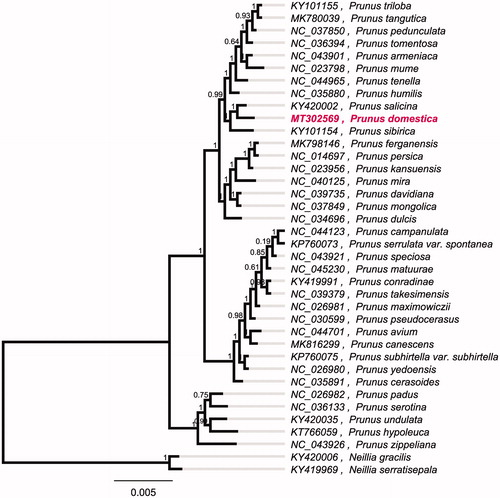Abstract
Prunus domestica commonly known as European plum is one of the most important wild fruit tree resources, and up to date, its wild community has only been found to be distributed in wild fruit forest area of the Tianshan Mountainsin Ili region of Xinjiang, China. Despite its agricultural importance and long history of cultivation, many questions remain about the origin of this species, due to absence of genome data. In this study, the complete chloroplast (cp) genome sequence of P. domestica was determined using next-generation sequencing. The entire cp genome was determined to be 157,395 bp in length. It contained large single-copy (LSC) and small single-copy (SSC) regions of 85,744 and 18,949 bp, respectively, which were separated by a pair of 26,351 bp inverted repeat (IR) regions. The genome contained 130 genes, including 85 protein-coding genes, 37 tRNA genes, and eight rRNA genes. The overall GC content of the genome is 36.8%. A phylogenetic tree reconstructed by 39 chloroplast genomes reveals that P. domestica is most closely related to Prunus salicina.
Prunus L. s.l. containing six subgenera, is mainly distributed in the northern hemisphere, including P. domestica, one of the most important wild fruit tree resources (Chase et al. Citation2016; Zhang et al. Citation2017). Up to date, its wild community has only been found to be distributed in wild fruit forest area of the Tianshan Mountainsin Ili region of Xinjiang, China (Lin and Shi Citation1989; Zhang et al. Citation1998). Despite its agricultural importance and long history of cultivation, many questions remain about the origin of this species, due to absence of genome data. So, it is necessary to develop genomic resources for P. domestica to provide basic intragenic information for the further study on phylogeny and breeding for genus Prunus.
Healthy leaf samples were collected from a wild P. domestica plant (43.38889 N,83.59198E, altitude 1235 m). The total genomic DNA was extracted from the fresh leaves of P. domestica using the DNeasy Plant Mini Kit (Qiagen, Valencia, CA, USA). The voucher specimen was deposited at Xinjiang agricultural university characteristic fruit tree research center (19sd-c-022). The whole genome sequencing was conducted on the Illumina Hiseq 4000 Sequencing System (Illumina, Hayward, CA). The filtered sequences were assembled using the program SPAdes assembler 3.10.0 (Bankevich et al. Citation2012). Annotation was performed using the DOGMA (Wyman et al. Citation2004). and tRNAscan (Schattner et al. Citation2005).
The plastome of P. domestica was determined to comprise double stranded, circular DNA of 157,395 bp containing two inverted repeat (IR) regions of 26,351 bp each, separated by large single-copy (LSC) and small single-copy (SSC) regions of 85,744 and 18,949 bp, respectively (Genome Warehouse acc. no. GWHALOD01000000; GenBank acc. no. MT302569). The genome contained 130 genes, including 85 protein-coding genes, 37 tRNA genes, and eight rRNA genes. The six protein-coding genes, six tRNA genes and four rRNA genes were duplicated in IR region. nineteen genes contained two exons and four genes (clpP and ycf3 and two rps12) contained three exons. The overall GC content of P. domestica cp genome is 36.8% and the corresponding values in LSC, SSC and IR regions are 34.6, 30.5 and 42.6%, respectively.
To investigate its taxonomic status, a maximum likelihood (ML) was reconstructed based on whole chloroplast genomes from 37 Prunus plants and two outgroup plant (Neillia gracilis and Neillia serratisepala) by Mafft version 1.4 and FastTree version 2.1.10 (Price et al. Citation2010). The ML phylogenetic tree shows that P. domestica is most closely related to Prunus salicina, with bootstrap support values of 100%. Chloroplast genomes of P. domestica adds valuable information for understanding the phylogenetic position of P. domestica in the subgenera Prunus. And more genome data of Prunus are needed to reveal the origin of P. domestica ().
Disclosure statement
No potential conflict of interest was reported by the author(s).
Data availability
The complete chloroplast genome sequence of Prunus domestica is deposited in the Genome Warehouse (https://bigd.big.ac.cn/search?dbId=gwh&q=GWHALOD01000000&page=1).
Additional information
Funding
References
- Bankevich A, Nurk S, Antipov D, Gurevich AA, Dvorkin M, Kulikov AS, Lesin VM, Nikolenko SI, Pham S, Prjibelski AD, et al. 2012. SPAdes: a new genome assembly algorithm and its applications to single-cell sequencing. J Comput Biol. 19(5):455–477.
- Chase MW, Christenhusz MJM, Fay MF, et al. 2016. An update of the Angiosperm Phylogeny Group classification for the orders and families of flowering plants: APG IV. Bot J Linn Soc. 181(1):1–20.
- Lin P, Shi L. 1989. The discovery and distribution of Ili wild Prunus domestica (P. communis Fritsch) in Xinjiang. Proceedings of International Symposium on Horticultural Germplasm, Cultivated and Wild; Beijing (China). p. 282–286.
- Price MN, Dehal PS, Arkin AP. 2010. FastTree 2-approximately maximum-likelihood trees for large alignments. PLoS One. 5(3):e9490.
- Schattner P, Brooks AN, Lowe TM. 2005. The tRNAscan-SE, snoscan and snoGPS web servers for the detection of tRNAs and snoRNAs. Nucleic Acids Res. 33(Web Server issue):W686–W689.
- Wyman SK, Jansen RK, Boore JL. 2004. Automatic annotation of organellar genomes with DOGMA. Bioinformatics. 20(17):3252–3255.
- Zhang JY, Liu WS, Lin PJ, Blanchet P. 1998. Preliminary report about wild Prunus domestica L. in Xinjiang (Western China). Acta Hortic. 478(478):347–350.
- Zhang S-D, Jin J-J, Chen S-Y, Chase MW, Soltis DE, Li H-T, Yang J-B, Li D-Z, Yi T-S. 2017. Diversification of Rosaceae since the Late Cretaceous based on plastid phylogenomics. New Phytol. 214(3):1355–1367.

